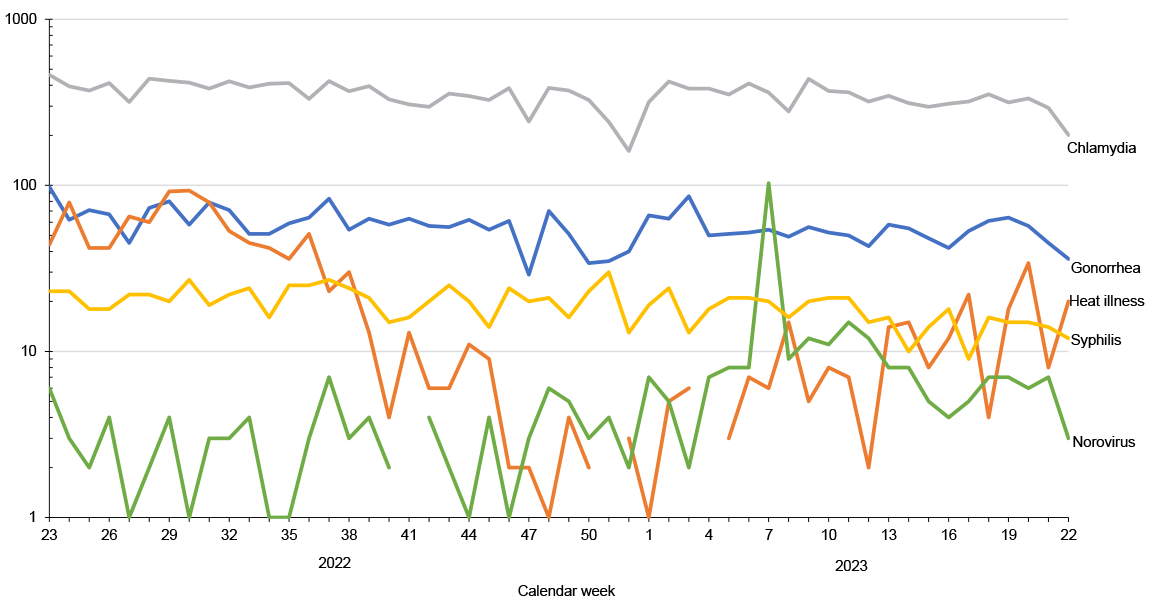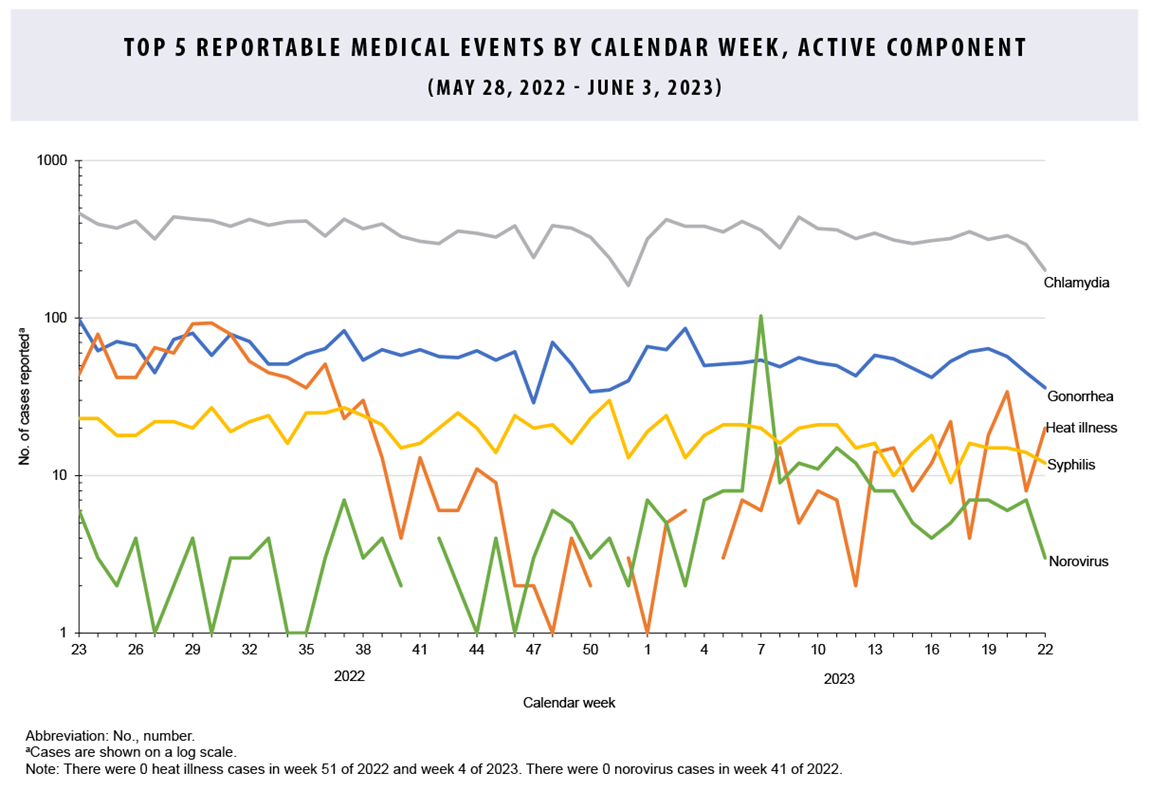Reportable Medical Events, Military Health System Facilities, Week 22, Ending June 3, 2023
 Graph depicting the frequency of the five most common reportable medical events within the Military Health System over the preceding year.
Graph depicting the frequency of the five most common reportable medical events within the Military Health System over the preceding year.
Reportable Medical Events are documented in the Disease Reporting System internet by health care providers and public health officials across the Military Health System for the purpose of monitoring, controlling, and preventing the occurrence and spread of diseases of public health interest or readiness importance. These reports are reviewed by each service’s public health surveillance hub. The DRSi collects reports on over 70 different RMEs, including infectious and non-infectious conditions, outbreak reports, STI risk surveys, and tuberculosis contact investigation reports. A complete list of RMEs is available in the 2022 Armed Forces Reportable Medical Events Guidelines and Case Definitions.1 Data reported in these tables are considered provisional and do not represent conclusive evidence until case reports are fully validated.

Total active component cases reported per week are displayed for the top five RMEs for the previous year. Each month, the graph is updated with the top five RMEs, and is presented with the current month’s (May 2023) top five RMEs, which may differ from previous months. COVID-19 is excluded from these graphs due to changes in reporting/case definition updates in 2023.

References
- Armed Forces Health Surveillance Division. Armed Forces Reportable Medical Events. Accessed April 6, 2023. https://www.health.mil/Military-Health-Topics/Health-Readiness/AFHSD/Reports-and-Publications/Armed-Forces-Reportable-Medical-Events
- Defense Manpower Data Center. Department of Defense Active Duty Military Personnel by Rank/Grade of Service, October 31, 2022. https://dwp.dmdc.osd.mil/dwp/app/dod-data-reports/workforce-reports
- Defense Manpower Data Center. Armed Forces Strength Figures for January 31, 2023. https://dwp.dmdc.osd.mil/dwp/app/dod-data-reports/workforce-reports
- Navy Medicine. Surveillance and Reporting Tools–DRSI: Disease Reporting System Internet. https://www.med.navy.mil/Navy-Marine-Corps-Public-Health-Center/Preventive-Medicine/Program-and-Policy-Support/Disease-Surveillance/DRSI
You also may be interested in...
Article
May 27, 2022
How COVID-driven changes are improving the TRICARE Pharmacy System.
Article
May 27, 2022
Corneal collagen cross-linking, known as CXL, the first and only treatment to date that is proven to stop Keratoconus, KCN, progression.
Article
May 27, 2022
Each dog has his or her own rank, service, and uniform and is inducted in an enlistment or commissioning ceremony. Today, the Facility Dog Program at WRNMMC includes Sully, a yellow Lab who was former President George H.W. Bush’s service dog.
Article
May 12, 2022
Treating wounded soldiers for the first time was a life-changing experience for this enlisted medic.
Article
May 1, 2022
This is the first evaluation of ICD-10-CM-based cased definitions for COVID-19 surveillance among DOD health care beneficiaries. The 3 case definitions ranged from highly specific to a lower specificity, but improved balance between sensitivity and specificity.
Article
May 1, 2022
Data from surveys may be used to make public health decisions at both the installation and the Department of the Army level. This study demonstrates that a vast majority of soldiers were likely sufficiently engaged and answered both bogus items correctly. Future surveys should continue to investigate careless responding to ensure data quality in ...
Article
May 1, 2022
Tick-borne Encephalitis in Military Health System Beneficiaries, 2012–2021. Tick-borne encephalitis (TBE) is a viral infection of the central nervous system that is transmitted by the bite of infected ticks, mostly found in wooded habitats in parts of Europe and Asia
Article
May 1, 2022
This report summarizes incidence rates of the 5 most common sexually transmitted infections (STIs) among active component service members of the U.S. Armed Forces during 2013–2021. In general, compared to their respective counterparts, younger service members, non-Hispanic Black service members, those who were single and other/unknown marital status, ...
Article
Apr 11, 2022
During his speech at HIMSS, Lt. Gen. Place discusses clear and present dangers to military medical care.
Article
Apr 8, 2022
Dr. Jay Montgomery is a medical director for the Defense Health Agency’s Immunization Healthcare Division’s North Atlantic Region Vaccine Safety Hub. In his role, Montgomery helps address vaccine and immunization questions and concerns.
Article
Apr 6, 2022
Military Medical officials, including Army Lt. Gen. (Dr.) Ronald J. Place, Defense Health Agency director, back FY 23 Budget before the Senate Appropriations Committee, March 29, 2022.
Article
Apr 5, 2022
Rear Adm. Brandon Taylor was recently appointed to be the new director for the Defense Health Agency’s Public Health directorate. In an interview, he discussed how he is approaching his new role, his goals for Public Health within DHA, and the importance of Public Health to a medically ready force and a ready medical force.
Article
Apr 1, 2022
Exertional (or exercise-associated) hyponatremia refers to a low serum, plasma, or blood sodium concentration (below 135 mEq/L) that develops during or up to 24 hours following prolonged physical activity. Acute hyponatremia creates an osmotic imbalance between fluids outside and inside of cells.
Article
Apr 1, 2022
Exertional heat illness (hereafter referred to as heat illness) spans a spectrum from relatively mild conditions such as heat cramps and heat exhaustion, to more serious and potentially life-threatening conditions such as heat injury and exertional heat stroke (hereafter heat stroke).
Article
Apr 1, 2022
Exertional rhabdomyolysis is a potentially serious condition that requires a vigilant and aggressive approach. Some service members who experience exertional rhabdomyolysis may be at risk for recurrences, which may limit their military effectiveness and potentially predispose them to serious injury.
You are leaving Health.mil
The appearance of hyperlinks does not constitute endorsement by the Department of Defense of non-U.S. Government sites or the information, products, or services contained therein. Although the Defense Health Agency may or may not use these sites as additional distribution channels for Department of Defense information, it does not exercise editorial control over all of the information that you may find at these locations. Such links are provided consistent with the stated purpose of this website.
You are leaving Health.mil
View the external links disclaimer.
Last Updated: August 24, 2023